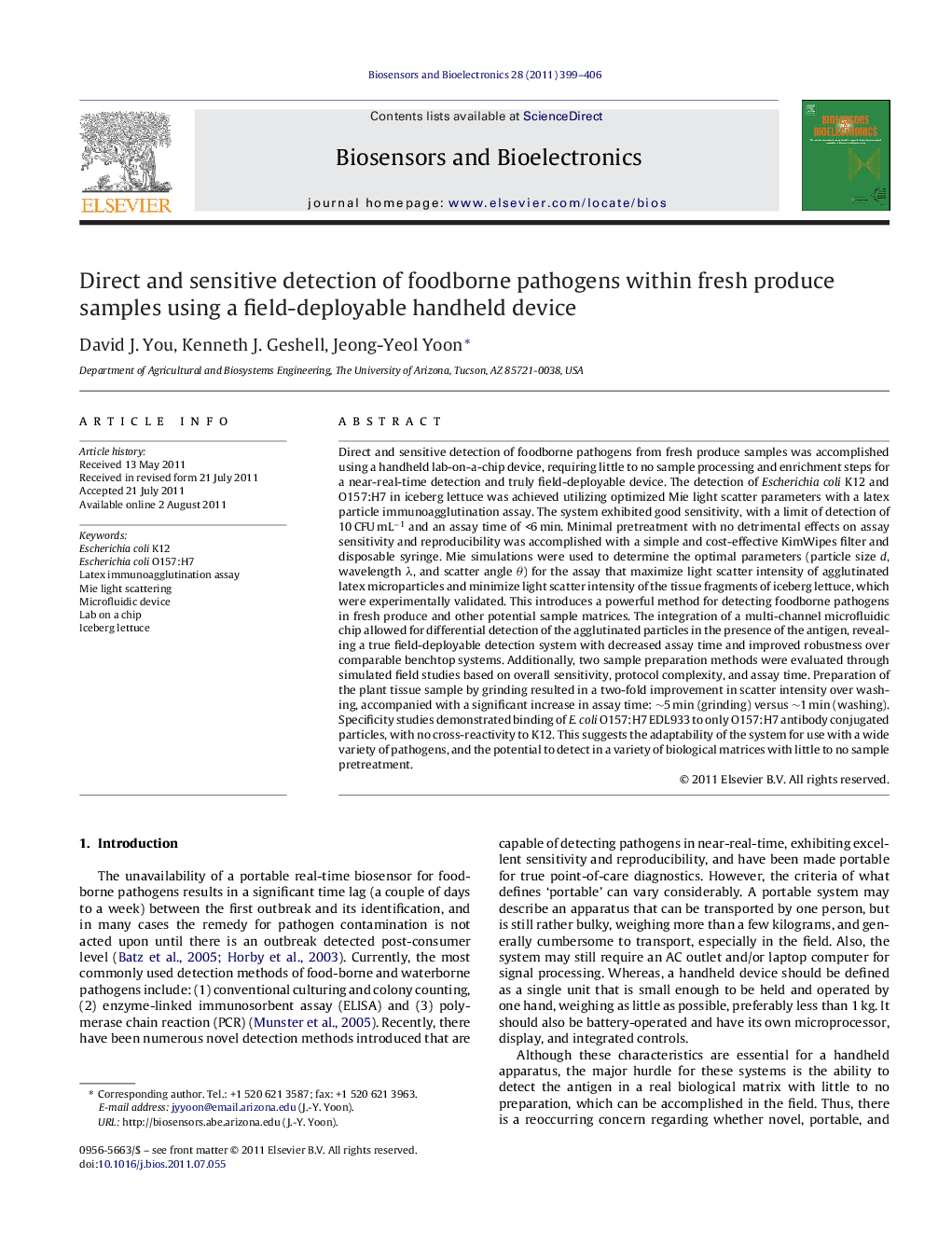| کد مقاله | کد نشریه | سال انتشار | مقاله انگلیسی | نسخه تمام متن |
|---|---|---|---|---|
| 10429503 | 909794 | 2011 | 8 صفحه PDF | دانلود رایگان |
عنوان انگلیسی مقاله ISI
Direct and sensitive detection of foodborne pathogens within fresh produce samples using a field-deployable handheld device
دانلود مقاله + سفارش ترجمه
دانلود مقاله ISI انگلیسی
رایگان برای ایرانیان
کلمات کلیدی
موضوعات مرتبط
مهندسی و علوم پایه
شیمی
شیمی آنالیزی یا شیمی تجزیه
پیش نمایش صفحه اول مقاله

چکیده انگلیسی
Direct and sensitive detection of foodborne pathogens from fresh produce samples was accomplished using a handheld lab-on-a-chip device, requiring little to no sample processing and enrichment steps for a near-real-time detection and truly field-deployable device. The detection of Escherichia coli K12 and O157:H7 in iceberg lettuce was achieved utilizing optimized Mie light scatter parameters with a latex particle immunoagglutination assay. The system exhibited good sensitivity, with a limit of detection of 10 CFU mLâ1 and an assay time of <6 min. Minimal pretreatment with no detrimental effects on assay sensitivity and reproducibility was accomplished with a simple and cost-effective KimWipes filter and disposable syringe. Mie simulations were used to determine the optimal parameters (particle size d, wavelength λ, and scatter angle θ) for the assay that maximize light scatter intensity of agglutinated latex microparticles and minimize light scatter intensity of the tissue fragments of iceberg lettuce, which were experimentally validated. This introduces a powerful method for detecting foodborne pathogens in fresh produce and other potential sample matrices. The integration of a multi-channel microfluidic chip allowed for differential detection of the agglutinated particles in the presence of the antigen, revealing a true field-deployable detection system with decreased assay time and improved robustness over comparable benchtop systems. Additionally, two sample preparation methods were evaluated through simulated field studies based on overall sensitivity, protocol complexity, and assay time. Preparation of the plant tissue sample by grinding resulted in a two-fold improvement in scatter intensity over washing, accompanied with a significant increase in assay time: â¼5 min (grinding) versus â¼1 min (washing). Specificity studies demonstrated binding of E. coli O157:H7 EDL933 to only O157:H7 antibody conjugated particles, with no cross-reactivity to K12. This suggests the adaptability of the system for use with a wide variety of pathogens, and the potential to detect in a variety of biological matrices with little to no sample pretreatment.
ناشر
Database: Elsevier - ScienceDirect (ساینس دایرکت)
Journal: Biosensors and Bioelectronics - Volume 28, Issue 1, 15 October 2011, Pages 399-406
Journal: Biosensors and Bioelectronics - Volume 28, Issue 1, 15 October 2011, Pages 399-406
نویسندگان
David J. You, Kenneth J. Geshell, Jeong-Yeol Yoon,